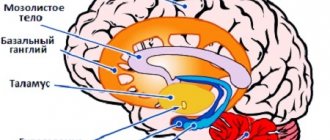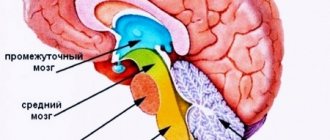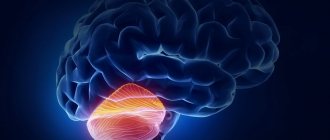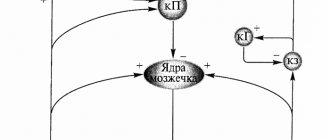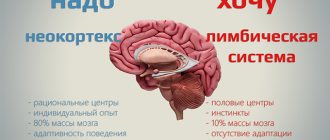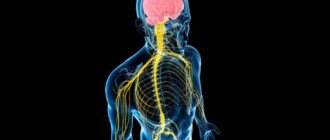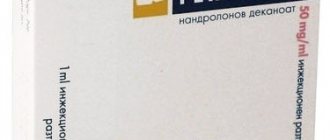Basal ganglia system
3D image - active brain, side view.
3D image - active brain, bottom view.
The basal ganglia are a complex of large structures located in the central part of the brain surrounding the central limbic system.
The basal ganglia are involved in the integration of feelings, thoughts and movements, as well as in regulating motor function. The basal ganglia set our body's regime, whether it operates in a state of rest or the level of anxiety. In addition, they help modulate motivation and are likely to contribute to feelings of pleasure and ecstasy. Let's look at each of these functions in more detail.
So, in the basal ganglia there is a process of integration of feelings, thoughts and movements. That is why, when you get excited, you jump up, when you get nervous, you tremble, when you get scared, you freeze in place, or you stand there, unable to utter a word when your boss scolds you. The basal ganglia are responsible for the gradual integration of emotions, thoughts and movements, so when overloaded they simply turn off. One of my patients suffered severe burns in a traffic accident. When he lay on the asphalt, engulfed in flames, those who were nearby froze in horror and could not take a single step to help him. For many years he could not get rid of the unpleasant feeling and understand why no one moved to help him. He was tormented by thoughts: “Did they really care? Am I really unworthy of help? For many years this man lived with the physical pain of his injuries and the mental pain of the indifference he faced. With what relief he learned that it was not a matter of indifference. The emotional shock of the very sight of the accident placed undue stress on the basal ganglia of eyewitnesses. As a result, they simply lost the ability to move, despite the fact that they most likely wanted to help.
When the basal ganglia are overactive (as is the case in people with high anxiety), the likelihood that a stressful situation will be too much for that person increases, and the person and his thoughts will freeze. For people with reduced activity in the basal ganglia (as in people with attention deficit disorder), it is a stressful situation that can push them into action. It is these people who are the first to arrive at the scene of an incident and react quite fearlessly to a stressful situation. For example, one of my friends who has ADD acts much faster in critical situations than I do. (As I mentioned in Chapter 2, I have a congenital overactivity of the basal ganglia.) I remember one day he and I were getting ready to leave a cafe and stood at the cash register to pay our check when suddenly the woman standing in front of us collapsed to the ground. My friend quickly began to help her, but I myself froze motionless from surprise and stress. At the same time, I myself am a doctor, but my friend is not! Previously, due to my inability to react quickly in such moments, I was constantly tormented by feelings of guilt. Subsequently, I realized with relief that my brain, or more precisely, the activity of the basal ganglia, did not allow me to act quickly in critical situations.
The basal ganglia are also responsible for fine motor skills, coordination, writing, etc. Let's look again at attention deficit disorder as an example. Many ADD patients, both children and adults, have terrible handwriting. The process of writing itself is difficult for them. Many adults and teens with ADD prefer to write in print because it does not require long, continuous, fluid movement. Many people with ADD complain that they have difficulty formulating their thoughts and putting them on paper. We know that medications that help with ADD are the psychostimulants Ritalin, Dexedrine or Adderall, which stimulate the basal ganglia to produce the neurotransmitter dopamine. After taking these medications, there is often a significant improvement in handwriting and the ability to express one's thoughts in writing. In addition, patients themselves say that taking these drugs generally improves their motor coordination. As an example, here are two samples of handwriting from the same patient, Tommy (14 years old), before and after treatment.
You can better understand what motor functions the basal ganglia are responsible for by looking at two diseases: Parkinson's disease and Tourette's syndrome. Parkinson's disease is caused by a deficiency of dopamine in the basal ganglia. It is manifested by hand tremors, muscle rigidity, difficulty moving, poor facial expressions, awkwardness and decreased motor activity. Often, the use of dopamine-stimulating drugs such as I-dopa significantly relieves these symptoms, allowing patients to move more easily and smoothly. The basal ganglia are also responsible for suppressing unwanted motor activity. When this part of the brain becomes abnormal, the risk of developing Tourette's syndrome, which is a combination of motor and vocal tics, increases. We will return to consider this condition later.
Based on the brain images obtained, we see that the basal ganglia are responsible for controlling the body's resting state or anxiety levels. Increased activity in the basal ganglia is often associated with anxiety, tension, wariness, and increased fear. Lack of basal ganglia activity causes problems related to motivation, energy, and ability to function.
Interestingly, among the most highly motivated individuals (such as CEOs) who underwent scanning, we noted high activity in this part of the brain. Thus, we can assume that in some cases, increased activity of the basal ganglia stimulates motivation, due to which these people become the “drivers” of society. Let's say my mother, who, like me, has slightly increased activity in the basal ganglia, can be a little anxious at times, but she is also a very active woman. She plays golf four or five times a week, has raised seven children without any apparent stress, and is always busy doing things for others. I believe that by using the excess energy generated by the increased activity of the basal ganglia in this way, it prevents the development of anxiety.
Another interesting finding is that the basal ganglia appears to be involved in controlling feelings of pleasure. At the Brookhaven National Laboratory in New York, a team led by Nora Volkova examined brain images to understand which centers were affected by cocaine and Ritalin. Both substances are absorbed primarily by the basal ganglia. Cocaine develops addiction, but Ritalin, in doses prescribed for ADD, does not. This study allowed us to confidently answer the question of why this happens. Cocaine greatly increases the uptake of dopamine by brain tissue. The concentration of this substance rapidly increases, and then just as rapidly decreases. A person who uses cocaine gets a wave of pleasure, but then it goes away, and then he (or she) wants to relive the feeling. Unlike cocaine, Ritalin, which also provides an influx of additional dopamine into the basal ganglia, acts more mildly, and after its use, dopamine levels decrease more slowly. Volkova's group hypothesized that cocaine cravings are triggered and perpetuated by activation of the basal ganglia. Ritalin, in turn, increases motivation, the ability to concentrate and focus for long periods of time, but does not cause the “coming” and desire to take more of it. (We do not consider cases where a person uses this drug in doses significantly higher than those used in clinical practice.) Thus, addiction does not occur. In fact, when I prescribe this drug to teenagers with ADD, I often find that they simply forget to take it.
Intense love affects the brain much like cocaine, releasing a powerful hit of dopamine in the basal ganglia. Love actually produces a distinct physical effect. I once scanned the brain of my friend Bill shortly after he met his lover. He was, as they say, head over heels in love with her. After the third date, which they spent on the ocean shore in each other’s arms, he came to my work to tell me about his new love. He was so happy that his state resembled euphoria. And it just so happened that while Bill was sitting with me, our technician came to me and said that we had an extra dose of the isotope left, and therefore, if I need to do an unscheduled scan, then there is such an opportunity. I already had a picture of my friend's brain that I took for the control group, which contains pictures of normal brain function. And then I decided to take a second shot of him. What I saw shocked me, without exaggeration. His brain looked as if he was under the influence of a large dose of cocaine. Activity in both the left and right basal ganglia was extremely high, almost like during a seizure. Love has the same powerful effect on the brain as drugs.
The basal ganglia are located deep in the cerebrum between the frontal lobes and the diencephalon. These include the caudate nucleus, putamen (together they make up the striatum), and the globus pallidus. The subthalamic nucleus and the substantia nigra are closely related functionally to these structures. The functions of the basal ganglia were studied using methods of local irritation or destruction, recording electrical activity, and monitoring manifestations of dysfunction in humans with damage to the basal ganglia. They are closely connected with each other, as well as with various parts of the cerebral cortex, the cerebellum, the red nucleus, and other nuclei of the brain stem. There are two types of excitation circulation in the basal ganglia - the putamen cycle and the caudate nucleus cycle. The putamen cycle, together with the motor areas of the cerebral cortex, provides complex movements. For example, writing, hand movements of a surgeon, pianist, etc. These movements require preliminary training and training. The cycle begins in the premotor and additional motor areas of the cerebral cortex, / spreads towards the putamen (past the caudate nucleus) to the inner part of the globus pallidus, then to the thalamus and again to the cerebral cortex, i.e. in the primary motor zone, premotor and supplementary areas. There are also auxiliary cycles of excitation circulation (with the participation of the subthalamic nucleus and the substantia nigra). In case of damage to the shell, spontaneous trembling of various parts of the body is observed both at rest and during voluntary movements. This is observed in patients with chorea. In case of damage to the globus pallidus, on the contrary, hypokinesis occurs. Cycle of the caudate nucleus. During this cycle, excitation circulates from the frontal zones of the brain through the parietal and occipital zones to the temporal region. The caudate nucleus receives impulses from the association zones of the cerebral cortex, then impulses go to the putamen, globus pallidus, thalamus and finally to the motor zones of the cerebral cortex. The role of this cycle is to synthesize sensory inputs and information stored in memory. This cycle regulates not individual movements, but their patterns corresponding to a specific goal (for example, behavior when meeting a dangerous animal). This cycle is involved in the process of regulating the speed and magnitude of movements performed. In the case of pathology of the basal ganglia, these parameters are violated. Neurotransmitters of the basal ganglia. Much attention is paid to the study of the mechanisms of impulse transmission in the ganglia with the participation of various mediators. Neurons that connect the substantia nigra with the caudate nucleus and putamen release dopamine. Information from the caudate nucleus and putamen is transmitted to the globus pallidus and substantia nigra via GABA. Through acetylcholine, effects are realized from the cerebral cortex to the caudate nucleus and putamen. Neurons of the brain stem secrete various neurotransmitters - norepinephrine, serotonin, enkephalin, etc. GABA and dopamine are inhibitory transmitters, acetylcholine is excitatory. Knowledge of the neurotransmitters of the basal ganglia is not only theoretical. In Parkinson's disease, when the function of the substantia nigra is impaired, an insufficient amount of dopamine is synthesized, and its deficiency occurs. Injecting dopamine into patients is not effective because this drug cannot cross the blood-brain barrier. Therefore, its precursor, L-dioxyphenylalanine, is introduced, which is converted into dopamine in the brain. Thus, the basal ganglia play a significant role in the regulation of motor functions. They take part in creating a program of action that has a specific goal. The dominant motivation is important.
- Back
- Forward
